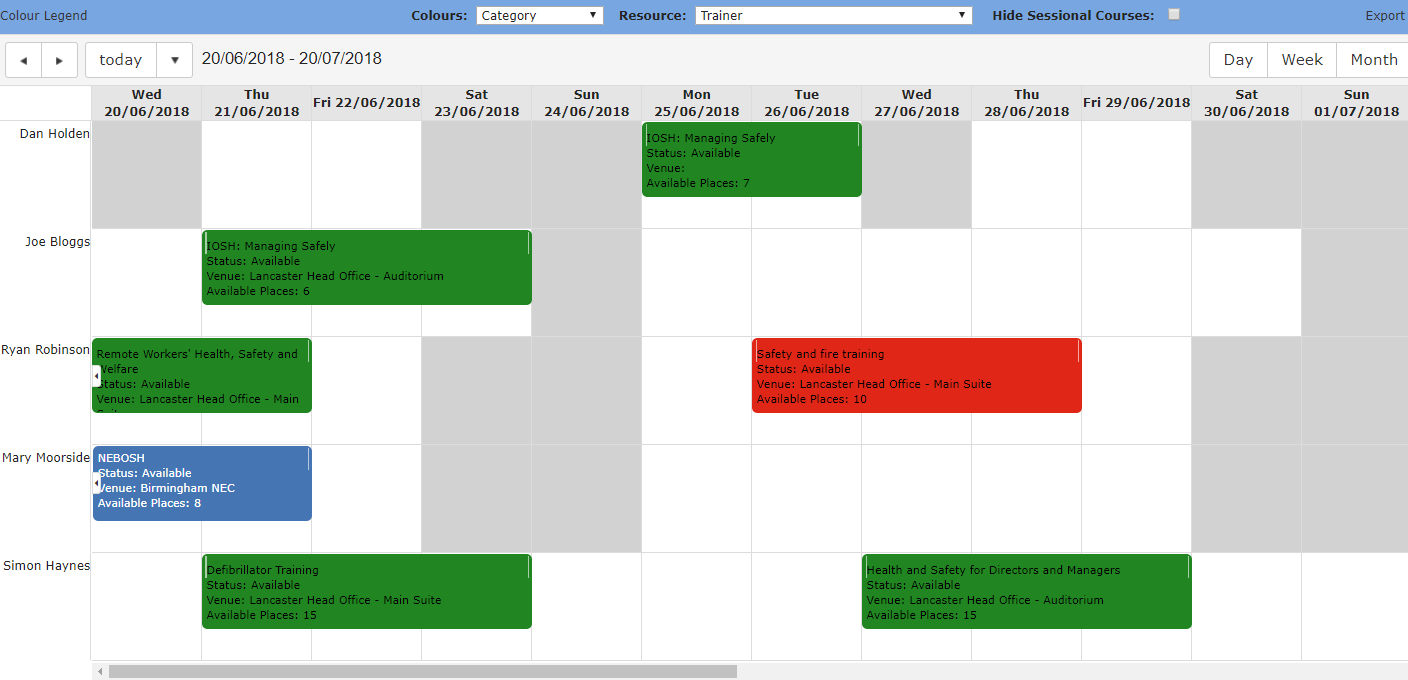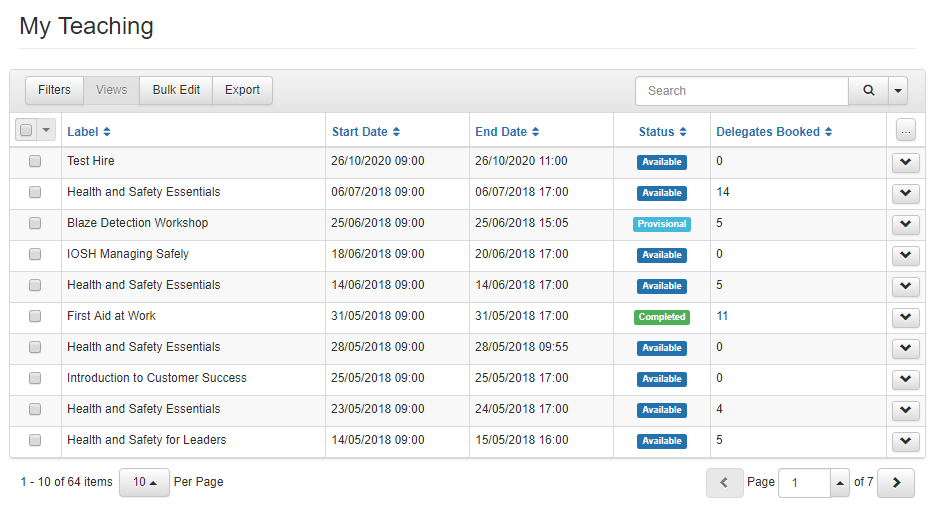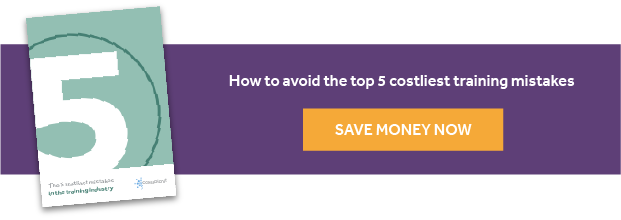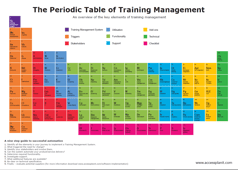Effective Training Resource Management For Maximum ROI

Resource management for training providers is a necessary but time consuming and sometimes complicated task. It is easy to leave it until the last minute to draft in a trainer for a course, or scramble around the store cupboard for a projector. Additionally, it can be difficult to allocate resources when it is unclear when venues are free or who is using what equipment.
Is this way of working going to achieve maximum ROI?
There's a better way.
Introduction
Trainer Management
Venue Management
Equipment & Other Resources
4 Top Tips To Maximise ROI
Introduction
It’s not difficult, it’s just simple maths. To increase profits you need to increase the number of delegates per course and reduce the variable costs. There are numerous ways to market your training courses to increase delegate numbers, but how often do you take a closer look at your training course resources?
Here we define resources as everything you need for your training course to go ahead. This includes your trainers, venues and equipment for the day. In this guide we break down each of these and explain how you can manage your resources more effectively for a greater ROI utilising available technology.
Trainer Management
They're by far your most important resource - let's cover trainers, instructors and facilitators first.
Managing your trainers diaries can be a huge time investment; in fact it's one of the most stressful tasks a training administrator has to deal with day-to-day. For some businesses, it's a walk in the park. This depends on a few factors:
- The number of trainers you have to coordinate
- The relationship you have with them (employed/freelance)
- The technology you have available
Most training businesses have some form of calendar setup that allows staff to see both their own schedule and access colleagues diaries. Sometimes this is enough, if trainers are employed by the training organisation.
The headaches typically surface for larger training organisations that work with a catalogue of freelance trainers that operate globally, where breakdowns in communication and delays in response can cause scheduling chaos.
Time is money, so ensuring your trainers know exactly where they should be and are instantly aware of any changes should be a high priority.
How to increase ROI
In order to increase ROI within trainer management, your most promising opportunity is to utilise available technology.
There's two big opportunities here in terms of time saving:
- Instant visibility over trainer availability
- Give more responsibility to the trainer
Instant visibility over availability
Course coordinators shouldn't have to spend any more than a couple of minutes establishing if a trainer is available on a given date.
Instant visibility is made possible if you use a training management system with integration. A two-way exchange integration function gives users the ability to add or amend diary entries in either the Outlook calendar or directly within the system.

Any changes are updated instantly and synchronised between the calendars, giving greater diary efficiency and reducing the risk of error or double booking. Trainers can access this on their mobile or tablet making this particularly useful for trainers and coordinators working remotely or in the field, as all changes will be accessible instantly on their personal calendars.
And, to ensure that entries cannot be overwritten or removed by other users, levels of permissions can be set.
Give more responsibility to the trainer
The 'dream' (atleast for busy training administrators) is to put more onus the trainer. Many training organisations have placed it in the hands of the trainer to:
- Confirm/Decline training online
- Download and print course material
- Generate live attendance lists
- Acquire course feedback online
Online course evaluations allows time saving for trainers and at the same time simplifies reporting. Other advantages include giving attendees more time to reflect making it more likely they will provide a more honest response.
Of course, in order to achieve the above, it relies on the trainer having their own portal or at the very least access to a shared document store and spreadsheet.
accessplanit have a portal created specifically for trainers that allows them to accept/decline training, see their schedule, mark unavailability and access course documentation.

The time savings and reduction in stress for training administrators means that they can put their time into something more fulfilling and meaningful for the business, like promoting courses online.
Venue Management
Alongside organising a trainer, arranging the appropriate training venue is of high importance.
For courses that are run at your own site, organising this is typically a fairly straightforward process. Room availability may be managed on a central spreadsheet, a dedicated training management system or even have it's own calendar set up on Outlook. It may even be a note on the door.
For courses run at an external venue, there's a few extra considerations such as cost, travel to the venue, accessibility and even accommodation.
Whether you run your courses in-house or at external venue, there's a few things to consider for both including:
- Room maximum capacity
- Room suitability and environment
- Location
- COVID-19 safe - Learn more about this in our webinar - "Safely Returning to the Classroom"
How to increase ROI
Organising a training venue shouldn't be a struggle. There's a number of things you can put in place to help increase ROI and reduce headaches within venue management:
- Set maximum numbers at each venue to avoid overbooking
- Create alerts when courses are filling fast to give you early warning and the opportunity to transfer to larger facilities or set up an additional session
- Create automated communications that will trigger if there is a change to the venue
- Automatically send detailed joining instructions to delegates
- Send attendance registers and name badges to external venues
- A central spreadsheet with contact details and representatives for each venue
Unfortunately, none of the above is possible without technology to give you a helping hand. As a minimum, it's imperative to have a CRM complete with email templates in order to mail merge key information and update delegates and trainers without too much fuss.
If you offer open courses, an online course booking system is a great way to determine maximum capacity limits and trigger automated communications.
It takes a dedicated training management system in order to action all of the above points. With accessplanit, once a venue has been assigned, booking places will be restricted to the venues max capacity. Once a booking has been received, joining instructions will be send for that particular venue based on a stored template. Course viability can be tracked using the stored venue cost, and any updates to the venue can trigger automatic communications to delegates and trainers alike. Venue management made easy!
Equipment & Other Resources
'Equipment' refers to all other material you will require on the day to allow your course to go ahead including:
- Technology (laptops, projectors etc)
- Training props (first aid dummies, harnesses etc)
- Handouts/Workbooks (training packs)
For the sake of cost tracking, it's even worth considering things like:
- Transport (company car, train fare cost)
- Accommodation (for multi-day courses or distant locations)
How to increase ROI
Whatever resource you would like to keep tabs on, dedicated software can help. Whether this is the availability or stock level of a resource, you need individual records for each item. It may be as simple as an online tracker to see how many workbooks you have remaining.
Within a training management system, you can tag each laptop, projector or equipment specific to your courses and see at a glance exactly which course, room and trainer these are assigned to. This not only acts as an audit when equipment breaks, the requirement can be cloned if you run identical courses and administrators can see instantly if any equipment is lying idle, becoming a cost to the business.
One great little feature of accessplanit's training management system is the post course viability screen which automatically calculates each course profit or loss, taking into account all costs associated with the course. This is a great way to see at a glance when a course has been profitable.
You can learn more about resource management with accessplanit in the video below.
When resource planning you want to ensure that it is going to be cost effective, time effective and perceived as effective by your customers. One word: effective. Effective resource management impacts on all aspects of a business including profitability, reputation and can even improve employee satisfaction.
We have compiled and listed four tips to gain maximum ROI from your resource management.
4 Top Tips To Gain Maximum ROI
1. Plan ahead
Take a look at your course schedules in advance and plan what you need for each of the sessions. Make sure you take into consideration the potential number of attendees, trainer competencies and course cost vs resource cost. This can reduce the risk of duplication or double booking by clearly identifying where your resources need to be and when.
2. Utilise available technology
If we haven't emphasised it enough above, here it is again.
There are so many products available today to help to manage your resources including training management software and various other scheduling tools; use them. From a quick calendar overview of resource availability to setting venue capacity limits to avoid overbooking, there are many features that can aid and assist your resource management.
Allowing trainers to log into their own system gives them the ability to easily see their upcoming courses, input availability and access course materials. It also saves huge amounts of training administration time.
Any aspect that you can automate will save time, minimise risk and allow energies to be focused elsewhere. For help with identifying the right software solution for your needs, download our free software comparison chart.
3. Have a contingency plan
What happens if a trainer calls in sick? If the classroom gets flooded? If you’ve double booked your room? Without a contingency plan in place, these challenges might be difficult to overcome. This could be detrimental not only for your company image but it could also waste crucial time and resources that cannot be recovered. That’s why it is important to ensure that you have prepared for these unexpected incidents and have provisions in place if any problems were to occur.
4. Measure resource effectiveness
Saving the best for last; measuring resource effectiveness.
There are a number of ways to measure this. Firstly, reporting. Reporting on areas such as resource utilisation and viability is a great place to start. Do you really need to be employing a trainer if he only performs 3 hours of training in a month? By the same token, is there one venue that doesn’t seem to be getting allocated for whatever reason? Automated reports can help you answer these questions and ensure that your resources are allocated efficiently to gain maximum ROI. This information can help in identifying improvements and any areas where savings could be made.
Delegate feedback is also a great way to assess how effective your resources are. When sending out post course surveys, take the opportunity to ask questions such as:
- How would you rate the trainer?
- How would you rate the venue?
- How would you rate the facilities available?
This is a great way to see things from your customers’ perspective and improve the perception of your company.
A third source that you may not have considered is staff feedback. It is important to make sure that you are getting regular feedback from those who handle the day to day resource management. They see it in action and may have suggestions on how to improve efficiency and in turn ROI.
Automated software can help assist these three functions. This can provide a better understanding of course viability and indications on which courses are of the most value. This improves business visibility and can provide a guide for profit and loss forecasts. This is crucial in determining the most efficient allocation of resources and areas of the business that might need improvement.
Take a look at other areas that could be impacting on your training business and where efficiencies could be made through a training management system by downloading free '5 costliest mistakes in training' eBook.
 Other related articles include:
Other related articles include:
How To Maximise ROI From Your Learning Management Software
How Feedback Can Benefit Your Training Company


